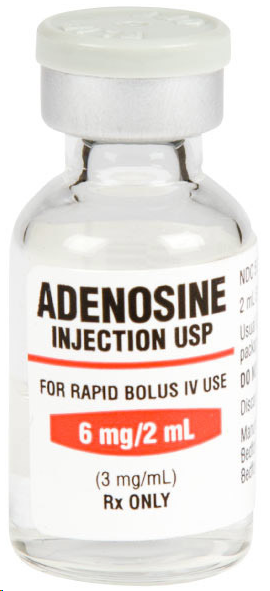1/Thread
Why Would Adeno...

Metadata
- Author: @AvrahamCooperMD on Twitter
- Full Title: 1/Thread
Why Would Adeno... - Category: #tweets
- URL: https://twitter.com/AvrahamCooperMD/status/1571513193163276288
Highlights
- 1/THREAD
Why would adenosine, a purine nucleoside, be able to treat supraventricular tachycardias (SVT)?
And why are its effects so short lived (e.g. <2 seconds)?
The answers will change the way you think about this drug.
#tweetorial #medtwitter
 (View Tweet)
(View Tweet) - 2/
Adenosine is an endogenous purine nucleoside that gets incorporated into RNA, ATP, and cAMP.
It has pleomorphic effects as a signaling molecule via A1, A2A, A2B, and A3 receptors.
https://t.co/6OFV7CHTVP
 (View Tweet)
(View Tweet) - 3/
Adenosine was first found to be able to terminate supraventricular tachycardias (SVT) in 1927 in animal experiments.
💡It's mechanism of action was unknown.
https://t.co/zxBAYCuDvm
 (View Tweet)
(View Tweet) - 4/
Along with vagal maneuvers and other nodal blockers, adenosine, is now used to treat hemodynamically stable, narrow complex SVT, particularly if involving the AV node w/ reentry loops (eg AVNRT).
https://t.co/InWMsjWShb
 (View Tweet)
(View Tweet) - 5/
Let's return to our first question. Why would a nucleic acid be able to terminate SVT?
It turns out that adenosine, which is produced endogenously by ATP hydrolysis, acts on the SA and AV nodes via A1 receptors.
https://t.co/E8dAMc1aZR
 (View Tweet)
(View Tweet) - 6/
Signaling via A1 adenosine receptors in cardiac tissue leads to ⬇️ cAMP activity and opening of hyperpolarizing membrane potassium channels.
🔑This decreases conduction speed through the AV node (aka negative dromotropy).
https://t.co/0Ndx2ZS6UU
 (View Tweet)
(View Tweet) - 7/
Adenosine signaling through A1 receptors also blocks the opening of L-type membrane calcium channels, which further reduces conduction speed through the AV node.
https://t.co/bYdKu2bRK3
 (View Tweet)
(View Tweet) - 8/
By dramatically slowing conduction in the AV node, adenosine can terminate reentrant circuits/loops that involve the AV node (eg AVNRT).
⚡️That's how it treats SVT.
https://t.co/E0OIGyARzK
 (View Tweet)
(View Tweet) - 9/
Let's return to our second question: why is adenosine such an ultra short-acting drug?
💥It turns out that adenosine's half-life in the blood is, incredibly, <1.5 seconds.
https://t.co/YaYFPS8fvt
 (View Tweet)
(View Tweet) - 10/
For adenosine inactivation to be so fast, it has to happen in the blood.
And that's exactly what occurs... (View Tweet) - 11/
Amazingly, adenosine is rapidly taken up by red blood cells (RBCs) and endothelial cells and inactivated intracellularly, in 2 ways:- Deamination by adenosine deaminase to inosine
- Phosphorylation to adenosine monophosphate
https://t.co/bYdKu2bRK3
 (View Tweet)
(View Tweet)
- 12/
Let's conclude with a cool clinical correlate.
Adenosine also causes vasodilation, via similar membrane hyperpolarizing mechanisms as we saw for negative dronotropy in tweet #6.
https://t.co/E8dAMc1aZR
 (View Tweet)
(View Tweet) - 13/
This ability to vasodilate explains why adenosine is used during pharmacologic cardiac stress testing.
Vasodilation of normal arterioles "steals" blood away from stenotic segments, inducing myocardial ischemia.
https://t.co/0P7yGXWWbw
 (View Tweet)
(View Tweet) - 14/
Dipyrimadole, another vasodilator used in stress testing, acts as an adenosine re-uptake inhibitor.
This prolongs and enhances the effects of endogenous adenosine on the myocardium, leading to coronary steal from stenotic coronary segments.
https://t.co/wfnrKfMkYV
 (View Tweet)
(View Tweet) - 15/
Teleologically, adenosine regulates cardiac energy supply/demand, allowing rapid response to ischemia/tissue injury by coronary vasodilation and ⬇️ conduction speed/heart rate.
This may explain why it has such an ultrashort duration of effect.
https://t.co/cOuugWW6Su
 (View Tweet)
(View Tweet) - 16/SUMMARY
🫀Adenosine terminates SVTs by ⬇️ conduction speed through the AV node (negative dromotropy)
🫀Ultrashort duration of action (<2 sec) = rapid inactivation in endothelial cells + RBCs
🫀This reflects its role in regulating response to cardiac ischemia/injury (View Tweet)